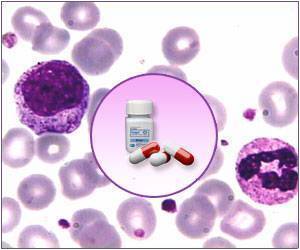The interaction between FLT3 mutations and RUNX1 activity in the induction of acute myeloid leukemia, was explored in the study.
- Acute myeloid leukemia (AML) is a result of a combination of gene mutations, the most common mutation being in the FLT3 (FMS-like tyrosine kinase 3) gene.
- The mutant form of FLT3 increased levels of a transcription factor called RUNX1, revealed a new study.
- Though RUNX1, is a transcription factor with known tumor-suppressor function, elevated levels of RUNX1, after being activated by mutant FLT3 induces AML.
AML is a heterogeneous group of cancers triggered by genetic and epigenetic changes that together lead to abnormal and excessive proliferation of hematopoietic stem cells in the bone marrow and their subsequent failure to differentiate into white blood cells.
The prognosis for AML is poor due to relapse and treatment failure.
AML is characterized by an overproduction of immature white blood cells (WBC), called myeloblasts or leukemic blasts.
These immature WBCs prevent formation of normal blood cells by crowding the bone marrow.
Their immaturity hampers their ability to function properly to prevent or fight infection. It can also result in anemia due to shortage of red blood cells.
About 15% of childhood leukemia cases are AML. This disease is more likely to affect the older individuals, over the age of 60 years.
Among those diagnosed with AML, less than 6 % are younger than 20 years of age and more than 55 % are 65 years or older.
In 2007, there were about 44,240 new cases of leukemia in the United States.
Men have slightly more chances of being diagnosed with AML compared to women.
FLT3 Mutation
One of the most common mutation that causes AML is in the gene encoding the cell surface signaling protein FLT3. Patients with this mutation show poor rates of survival.Though the mutant form of FLT3 can promote proliferation of hematopoietic stem cells, this mutation is not enough to block their differentiation into white blood cell and trigger AML on its own, according to experiments in mice.
Increased Levels of RUNX1
Carol Stocking and colleagues at the Heinrich-Pette-Institute, Leibniz Institute for Experimental Virology in Hamburg noticed an increased level of a transcription factor called RUNX1 in many patients carrying the mutant form of FLT3 also showed."This was unexpected because up to 20% of AML patients carry mutations that inactivate RUNX1, which is generally considered to be a tumor suppressor that prevents the formation of leukemias," Stocking says.
When experimented in mice, researchers found that reducing RUNX1 levels reduced the ability of human AML cells expressing mutant FLT3 to form tumors. In contrast, elevated RUNX1 levels allowed the human AML cells expressing mutant FLT3 to induce AML.
Mouse hematopoietic stem cells that expressed mutation in FLT3 were highly proliferative, and when co-expressed with RUNX1 blocked their differentiation into white blood cells, thus resulting in AML.
Mutant FLT3 activates RUNX1 by promoting the transcription factor’s phosphorylation.
This activated RUNX1 then blocks white blood cell differentiation, by inducing another transcription factor called Hhex.
Hematopoietic stem cells expressing both Hhex and mutant FLT3 also gave rise to AML, the researchers found.
The results show that though RUNX1 may suppress the initiation of AML but, after being activated by mutant FLT3, it blocked white blood cell differentiation and promote tumor development.
"Therapies that can reverse this differentiation block may offer significant therapeutic efficacy in AML patients with FLT3 mutations," says Stocking.
"Ablating RUNX1 is toxic to leukemic cells but not to normal hematopoietic stem cells, so inhibiting RUNX1 may be a promising target in combination with FLT3 inhibitors." Stocking added.
The study, "RUNX1 cooperates with FLT3-ITD to induce leukemia," is published online in The Journal of Experimental Medicine.
References:
- Acute myeloid leukaemia (AML) - (http://www.leukaemia.org.au/blood-cancers/leukaemias/acute-myeloid-leukaemia-aml)
- Carol Stocking et al. RUNX1 cooperates with FLT3-ITD to induce leukemia. The Journal of Experimental Medicine; (2017) DOI: 10.1084/jem.20160927
















